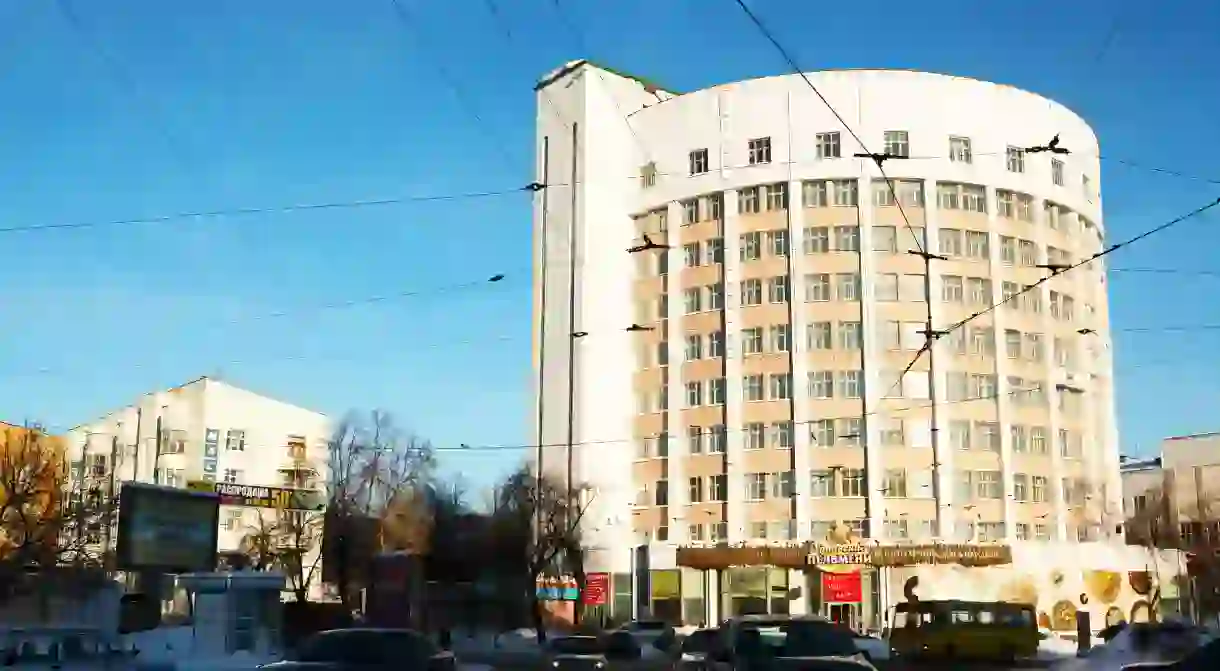A Walking Tour of Yekaterinburg's Most Iconic Constructivist Buildings

Lovers of design and architecture won’t want to miss Yekaterinburg’s constructivist buildings. At the forefront of innovation in the early 20th century, these structures pushed the collective, socialist cause with bold design, and now are important sights of cultural heritage. While some of these buildings are in varying states of neglect, they are still impressive sights not to be missed. So put on some good walking shoes and check them out.
Chekist Town
Building

A large residential complex in the heart of the city, the project was built in 1936 to house NKVD (the predecessor to KGB) workers. Originally, the complex was created to enhance the socialist aspirations of communal living. Flats had shared kitchens and bathrooms, and individual private spaces were reduced to maximise shared living quarters. The centrepiece of the complex is the Iset Hotel, a semicircular building that used to be dormitory-style accommodation. From an aerial view, the shape of the hotel and the adjacent building are supposed to resemble a hammer and sickle. The complex is also the namesake of a local indie band.
The Ural History and Archaeology Museum
Museum
Part of the Chekist Town complex, this building was originally a public cafeteria, meeting place, and apparently, a hot date spot for young, single NKVD staff. A passageway connects the cafeteria to the Iset Hotel, which had single dormitory accommodation, and special passageways and a spiral staircase connected the space to other residences in the complex. After the collapse of the Soviet Union, the building was handed over to the local government and has been a museum space ever since.
Sverdlovsk Film Studios
Building

Across from Chekist Town, the Sverdlovsk Film Studio shares a building with the City Centre Mall, and it is rumoured to be shaped like a tractor as well. Built in the late 1920s, the interior features open balconies, wide stairways and a roomy interior, although now it is cluttered with small shops. The building’s geometric exterior is well preserved, although, again, it is used as advertising space for the shops inside. The building is split into two parts, separated by an inner yard space.
The Printing House
Building
Right on the city‘s main drag, this old newspaper HQ is hard to miss. Large parts of the building remain unused; however, a section of it is a multipurpose art space that includes a restaurant, gallery, and one of the best gig venues in town. The Ural Biennale Festival has also reclaimed the space as a temporary art venue. Built in 1926, the building housed multiple publishing and printing companies and a local branch of the TASS photo agency. Printing facilities require bright light, and so there are continuous windows around the entire building’s perimeter, and a semicircular staircase juts out from the building. Although functional, these style features went on to become signature design elements in the movement.
General Post Office
Building

Also on Lenin Avenue, the still functioning GPO is shaped like a tractor in tribute to agricultural workers and collectivisation. Built in 1933, it is still currently a post office. However, back in the Soviet era, it was also a kindergarten, a day-care centre and housed a former radio theatre. There were rooms built specifically so workers could develop hobbies and enjoy social activities without leaving the workplace.
Dinamo Sports Complex
Building

Along the banks of the city ponds, the Dinamo Sports Complex deliberately evokes a nautical tone. V-shaped windows look like a bow, and the windowed balconies look like lifeboats. It was designed by leading Ural constructivist architect Venuamin Sokolov, one half of the team who designed the General Post Office Building. The local government wanted to tear the building down and replace it with a monument to the Great Patriotic War (WWII). However, locals petitioned against it, and for now, this iconic building is safe.
Madrid Hotel
Building
Apparently, the building was given its name when civil war broke out in Spain during its construction in 1933. Despite being built as a hotel, the building never became one. On completion, it became a female dormitory. Then, during WWII, it was used as an evacuation hospital, before reverting back to a women’s dormitory. The Madrid was built by Bela Scheffler, one of the several German architects who was brought over during the 1920s to help build worker settlements near newly constructed industrial plants. The building is currently unoccupied, for the most part, and the inside is a bit decrepit. However, if you peek inside you’ll find neoclassical additions added to the interior sometime in the late 1930s.
The White Tower
Building

Although this water tank might not appear as visually interesting as some of the other buildings around town, it is remarkable for several reasons. Just up the road from the Madrid Hotel, this old water tower was one of the first concrete structures built in the Ural region and the first to employ electrical technology during construction. It also was the largest water tower tank in the world at the time. Unused from the 1960s onwards, there have been many plans to rejuvenate the tower, however, few have come to fruition. However, The Ural branch of the National Centre for Contemporary Arts has, on occasion, used the tower as a pop up cultural space.













